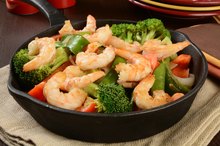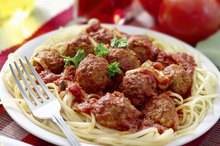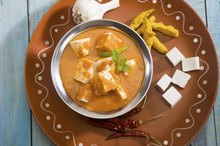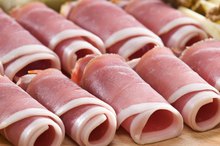How to Get the Carb Count at a Chinese Restaurant
Fast food from Chinese restaurants is loaded with carbohydrates, salt and fats 1. As you strive to control your carb count, enjoy Chinese food in moderation. Use carb counting, structured ordering, portion identification, slow and conscious eating and leftover planning to moderate your intake and keep your carb counts where you want them.
Count each 1/3 cup of rice as one carb count, or 15 g of carbohydrates. In a traditional Chinese restaurant, an individual bowl of rice is about 1 cup, or three carb counts. Fried rice has more fat and calories, but the carb count is the same--three per cup of rice. Brown rice has more fiber and nutrients then white but the same carbs. Your average fast food Chinese takeout lunch special has about 2.5 cups of fried rice, or 7.5 carbs and 570 calories.
Teriyaki Chicken Rice Bowl Calories
Learn More
Count each 1/4 cup of sweet sauce as one carb count. Count each 1/2 cup of thick salty sauce as one carb count due to the corn starch used for thickening. The average fast food Chinese takeout lunch special has about 1 cup of sauce, so four carbs and 300 calories.
Count each three-bite size piece of battered and deep fried chicken, shrimp or meat as one carb count, and add three fat counts. The average Chinese takeout lunch special has six to nine bite-size fried pieces.
Calories in Chinese Food With Shrimp & Broccoli
Learn More
Count each 1/3 cup of diced cooked vegetables (carrots, bell pepper, water chestnuts, baby corn, pea pods, etc.) as one carb count. Count each 1/2 cup of fruit as one carb count. Count each 1/2 cup of nuts as one carb count. The average Chinese takeout lunch special with vegetables, fruits and/or nuts will have about 1/2 cup of each, or about 1.5 cups total.
Count each 1 and 1/2 cups of cooked green leafy vegetables (bok choy, celery, spinach, cabbage etc.) as one carb count. Green leafy vegetables are your best value for carb counting.
Tips
Carb counting is easy at the Chinese restaurant. Begin by knowing your carb allowance for the meal and then watch your portions and stick to your plan.
Choose dishes that make carb counting easier, such as those light on the sauce, without breading and with more leafy green vegetables.
Packing up the leftovers as you begin your meal will help you maintain your portion control.
Related Articles
References
- National Academy Press: Dietary Carbohydrates: Sugars and Starches
- National Academy Press: Macronutrients and Healthful Diets
- Nutrient Data Laboratory
- Volek, J. S., Sharman, M. J., Love, D. M., Avery, N. G., Scheett, T. P., & Kraemer, W. J. (2002). Body composition and hormonal responses to a carbohydrate-restricted diet. Metabolism, 51(7), 864-870.
- Bryer, S. C., & Goldfarb, A. H. (2006). Effect of high dose vitamin C supplementation on muscle soreness, damage, function, and oxidative stress to eccentric exercise. International Journal of Sport Nutrition and Exercise Metabolism, 16 (3), 270.
- Kesse-Guyot, E., Andreeva, V. A., Ducros, V., Jeandel, C., Julia, C., Hercberg, S., & Galan, P. (2014). Carotenoid-rich dietary patterns during midlife and subsequent cognitive function. British Journal of Nutrition, 111 (05), 915-923.
- Hemila, H., & Chalker, E. (2013). Vitamin C for preventing and treating the common cold. Cochrane Database Syst Rev, 1.
- Lembke, P., Capodice, J., Hebert, K., & Swenson, T. (2014). Influence of Omega-3 (N3) Index on Performance and Wellbeing in Young Adults after Heavy Eccentric Exercise. Journal of Sports Science & Medicine, 13(1), 151.
- Rule, D. C., Broughton, K. S., Shellito, S. M., & Maiorano, G. (2002). Comparison of muscle fatty acid profiles and cholesterol concentrations of bison, beef cattle, elk, and chicken. Journal of Animal Science, 80(5), 1202-1211.
- Pimpin, L., Wu, J. H., Haskelberg, H., Del Gobbo, L., & Mozaffarian, D. (2016). Is butter back? A systematic review and meta-analysis of butter consumption and risk of cardiovascular disease, diabetes, and total mortality. PLoS One, 11(6), e0158118.
- Nimalaratne, C., Lopes-Lutz, D., Schieber, A., & Wu, J. (2011). Free aromatic amino acids in egg yolk show antioxidant properties. Food Chemistry, 129(1), 155-161.
- Ceballos, L. S., Morales, E. R., de la Torre Adarve, G., Castro, J. D., Martinez, L. P., & Sampelayo, M. R. S. (2009). Composition of goat and cow milk produced under similar conditions and analyzed by identical methodology. Journal of Food Composition and Analysis, 22(4), 322-329.
- Sae?tan, S., Rogers, C. J., & Lambert, J. D. (2014). Voluntary exercise and green tea enhance the expression of genes related to energy utilization and attenuate metabolic syndrome in high fat fed mice.Molecular Nutrition & Food Research, 58(5), 1156-1159.
- Harms-Ringdahl, M., Jenssen, D., & Haghdoost, S. (2012). Tomato juice intake suppressed serum concentration of 8-oxodG after extensive physical activity. Nutrition Journal, 11(1), 29.
Writer Bio
With 20 years of experience in nutrition coaching, research, writing and professional cooking, Jessi C. Allender blends culinary art with nutrition science. Allender earned her Master of Science in clinical nutrition from Rush University and is a registered/licensed dietitian. She trained as a chef at the California Culinary Academy and worked in top restaurants around the country.








